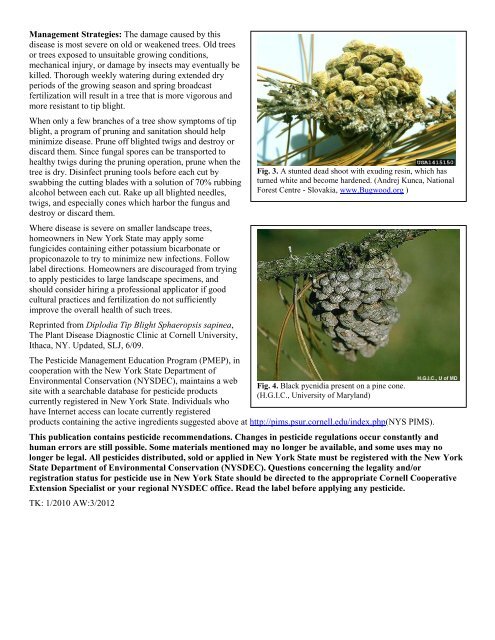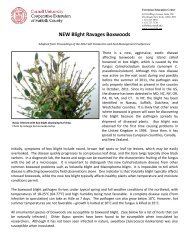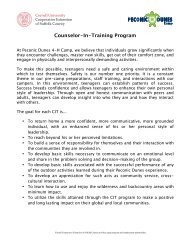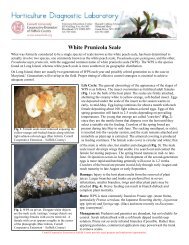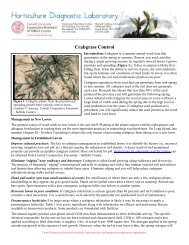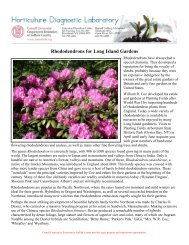Diplodia Tip Blight - Cornell Cooperative Extension of Suffolk County
Diplodia Tip Blight - Cornell Cooperative Extension of Suffolk County
Diplodia Tip Blight - Cornell Cooperative Extension of Suffolk County
Create successful ePaper yourself
Turn your PDF publications into a flip-book with our unique Google optimized e-Paper software.
Management Strategies: The damage caused by this<br />
disease is most severe on old or weakened trees. Old trees<br />
or trees exposed to unsuitable growing conditions,<br />
mechanical injury, or damage by insects may eventually be<br />
killed. Thorough weekly watering during extended dry<br />
periods <strong>of</strong> the growing season and spring broadcast<br />
fertilization will result in a tree that is more vigorous and<br />
more resistant to tip blight.<br />
When only a few branches <strong>of</strong> a tree show symptoms <strong>of</strong> tip<br />
blight, a program <strong>of</strong> pruning and sanitation should help<br />
minimize disease. Prune <strong>of</strong>f blighted twigs and destroy or<br />
discard them. Since fungal spores can be transported to<br />
healthy twigs during the pruning operation, prune when the<br />
tree is dry. Disinfect pruning tools before each cut by<br />
swabbing the cutting blades with a solution <strong>of</strong> 70% rubbing<br />
alcohol between each cut. Rake up all blighted needles,<br />
twigs, and especially cones which harbor the fungus and<br />
destroy or discard them.<br />
Where disease is severe on smaller landscape trees,<br />
homeowners in New York State may apply some<br />
fungicides containing either potassium bicarbonate or<br />
propiconazole to try to minimize new infections. Follow<br />
label directions. Homeowners are discouraged from trying<br />
to apply pesticides to large landscape specimens, and<br />
should consider hiring a pr<strong>of</strong>essional applicator if good<br />
cultural practices and fertilization do not sufficiently<br />
improve the overall health <strong>of</strong> such trees.<br />
Reprinted from <strong>Diplodia</strong> <strong>Tip</strong> <strong>Blight</strong> Sphaeropsis sapinea,<br />
The Plant Disease Diagnostic Clinic at <strong>Cornell</strong> University,<br />
Ithaca, NY. Updated, SLJ, 6/09.<br />
The Pesticide Management Education Program (PMEP), in<br />
cooperation with the New York State Department <strong>of</strong><br />
Environmental Conservation (NYSDEC), maintains a web<br />
site with a searchable database for pesticide products<br />
currently registered in New York State. Individuals who<br />
have Internet access can locate currently registered<br />
products containing the active ingredients suggested above at http://pims.psur.cornell.edu/index.php(NYS PIMS).<br />
This publication contains pesticide recommendations. Changes in pesticide regulations occur constantly and<br />
human errors are still possible. Some materials mentioned may no longer be available, and some uses may no<br />
longer be legal. All pesticides distributed, sold or applied in New York State must be registered with the New York<br />
State Department <strong>of</strong> Environmental Conservation (NYSDEC). Questions concerning the legality and/or<br />
registration status for pesticide use in New York State should be directed to the appropriate <strong>Cornell</strong> <strong>Cooperative</strong><br />
<strong>Extension</strong> Specialist or your regional NYSDEC <strong>of</strong>fice. Read the label before applying any pesticide.<br />
TK: 1/2010 AW:3/2012<br />
Fig. 3. A stunted dead shoot with exuding resin, which has<br />
turned white and become hardened. (Andrej Kunca, National<br />
Forest Centre - Slovakia, www.Bugwood.org )<br />
Fig. 4. Black pycnidia present on a pine cone.<br />
(H.G.I.C., University <strong>of</strong> Maryland)


